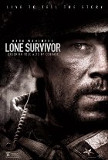Lone Survivor (United States, 2013)
January 07, 2014
In the mountains of Afghanistan, one man, injured and bleeding, struggles against impossible odds to stay alive. It's at this point that the focus of Peter Berg's Lone Survivor shifts from that of a war movie to that of a tale of survival. In retrospect, it's something of a minor miracle that every member of the military's Operation Red Wings didn't go home in a body bag. It's not that the mission was poorly planned, although too much faith was placed in uncertain communication methods, but it was undone by a freak and unfortunate coincidence. The result was a U.S. death toll of 19 for an action that was not initially viewed as being especially dangerous.
Lone Survivor is director Peter Berg's "reward" for making Battleship for Universal Pictures. The studio agreed to bankroll Lone Survivor only if Berg first helmed what they hoped would launch a new summer movie franchise. (We all know how that turned out.) The film is based on events that occurred on the ground in the Hindu Kush mountains of the Kunar province in June 2005 as related in the book co-authored by sole survivor Marcus Luttrell.
The movie starts out by introducing us to the four main characters, all Navy SEALs who will end up involved in a firefight with vastly superior numbers. In addition to Luttrell (Mark Wahlberg), we're presented with mission leader Michael Murphy (Taylor Kitsch), Danny Dietz (Emile Hirsch), and Matt "Axe" Axelson (Ben Foster). Lieutenant Commander Erik Kristensen, the overall commander of SEAL Team 10, is given a fair amount of screen time, possibly due to his being played by Eric Bana. The meet-and-great section of Lone Survivor is standard stuff - isolated vignettes designed to humanize the men who will end up in harm's way. Its effectiveness is limited; aside from Luttrell, the characters seem generic.
The objective of Operation Red Wings is the capture or elimination of a high-value Taliban leader. Four SEALs are placed on the ground to target him. The first problem they encounter is that neither their radio equipment nor their satellite phone works with regularity, leaving them cut off when a key decision needs to be made. Then, while they're in hiding, their position is approached by three goat herders. In what stands out as the film's most compelling sequence, the SEALs must make a life-and-death decision: abide by the rules of engagement and release their unarmed prisoners or kill men they believe could be Taliban spies. In a move that has led to much soul-searching by Luttrell and second-guessing throughout the military, the SEALs release the goat herders. Less than two hours later, they are ambushed and three of them don't survive. Even worse, a rescue helicopter is shot down, greatly increasing the death toll.
Berg's mix of traditional equipment and hand-held cameras proves effective in capturing the tension and chaos of the battle. The Americans suffer injuries not only because of the weapons of their attackers but because, in their retreat, they fall down steep slopes littered with rocks and other devastating debris. The film's treatment of battle is realistic in a grim, gruesome fashion. One extended sequence, beginning when the SEALs first take fire and ending when Luttrell falls asleep while in hiding, represents filmmaking at its most intense. Lone Survivor is graphic in its depiction of what happened to these men and is not for those who believe war movies should be sanitized. Some aspects of the production are similar to Robert Redford's Lions for Lambs (which may have in part been inspired by Operation Red Wings), but this is a more centered motion picture, maintaining its narrative momentum with a brisk pace.
The acting is solid but not of the type likely to attract awards considerations. Mark Walhberg is the film's glue and he's believable as a man who, despite taking an incredible amount of physical punishment, continues to struggle along. None of the other actors is given sufficient time to develop a legitimate character. Eric Bana in particular is wasted, although it has been reported that the actor, after reading the script, was willing to accept any role just to appear in the film.
It can be said that Lone Survivor does justice to Luttrell's story, providing a cinematic recreation of events that were related in great detail in the book and which Luttrell discussed in countless 2007 interviews. Lone Survivor can be seen as either a nihilistic chronicle of a mission gone wrong in which nearly all of the characters are killed or a tale of courage and survival about how one man defied the odds and returned home. Most war films try to be epic in scope and intent. Lone Survivor opts for a smaller focus and succeeds on its own terms.
Lone Survivor (United States, 2013)
Cast: Mark Wahlberg, Taylor Kitsch, Emile Hirsch, Ben Foster, Eric Bana
Screenplay: Peter Berg
Cinematography: Tobias A. Schliessler
Music: Steve Jablonsky
U.S. Distributor: Universal Pictures
U.S. Release Date: 2014-01-10
MPAA Rating: "R" (Violence, Disturbing Images, Profanity)
Genre: THRILLER/DRAMA
Subtitles: none
Theatrical Aspect Ratio: 2.35:1
Comments